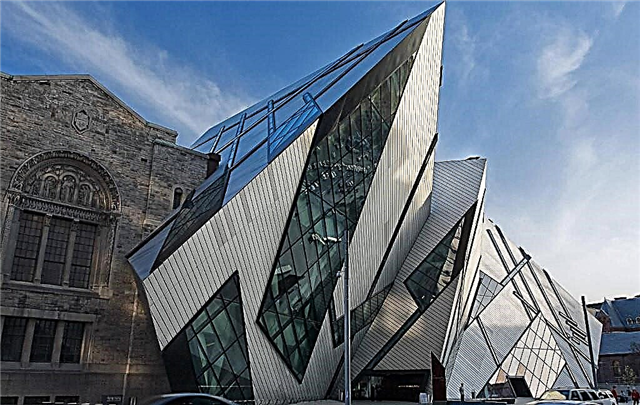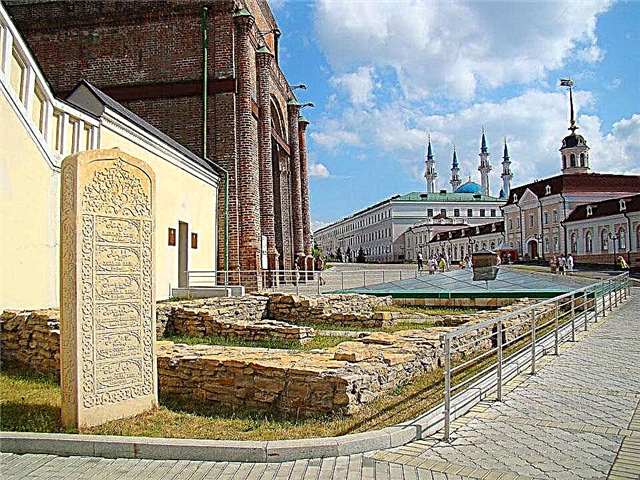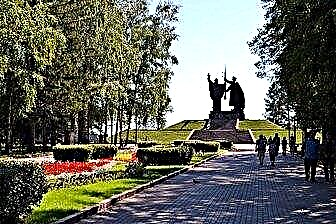Lying in the middle of the endless Siberian plains, Tomsk is one of the most interesting cities in the region. First of all, it is famous for its wooden architecture. Here are such masterpieces as "House with Firebirds", "House with a Tent", "House with Dragons" and the mansion of the architect S. V. Khomich. These buildings can be viewed endlessly and marvel at the skill of their creators.
Once A.P. Chekhov allowed himself to drop an impartial remark to Tomsk that this town is a very dull place and, apart from melancholy, does not cause any emotions. The townspeople did not forget the insult and repaid the writer in full, erecting a caricature monument in his honor on the embankment, which, as they say, cannot be looked at without tears.
In addition to the comical figure of Anton Pavlovich, there are many other cheerful monuments, as well as more traditional sights - churches, monasteries, parks and avenues.

The best hotels and hotels at affordable prices.
from 500 rubles / day
What to see and where to go in Tomsk?
The most interesting and beautiful places for walking. Photos and a short description.
Camp garden
City park in the Kirovsky district, which arose in the 19th century. Its name is due to the fact that in the 18th century, the summer camp of the Tomsk 39th Infantry Regiment was located on this place. Today, the garden is a picturesque natural monument right in the heart of the city and a popular promenade. In Soviet times, a sculpture of the Motherland and the Eternal Flame memorial complex were installed here.

Novo-Cathedral Square
The architectural appearance of the square began to take shape in the 40s. XIX century. The very first building of the provincial government appeared here in 1842. At the beginning of the 20th century, it became a place for holding rallies against the autocracy, in Soviet times - for festive demonstrations. In 2003, the square was decorated with a fountain, in 2004 - a monument to the students of Tomsk, and in 2006 - the Victory Alley memorial complex.

Tomsk State University
One of the key educational institutions in the region. The university was founded in 1878, and was built in honor of Emperor Alexander III. The initiative to create it was supported by large industrialists - PG Demidov, AM Sibiryakov, Z. Tsibulsky. The building was erected according to the project of A.K.Bruni. Part of the historical and architectural complex is the University Grove, founded in 1885 by the scientist P.N.Krylov.

Monument to Anton Chekhov
An unusual sculpture of the writer adorns the embankment of the Tom River. It was erected in honor of the 400th anniversary of the city in 2004. The monument was created by the sculptor L.A. Usov with voluntary donations. The master embodied the image of Anton Pavlovich, noticed "through the eyes of a drunken peasant lying in a ditch" - at least that's what the inscription on the pedestal says. Thus, the city, as it were, took revenge on the writer, who considered Tomsk a boring and not worthy of attention place.

Monument to the ruble
Monument made of wood, dedicated to the national currency. Its weight is 250 kg and its height is over 2 meters. A huge ruble was installed in 2008 on Novoslobodskaya Square; in 2014, after a vandal attack, it was transferred to the protected area of the Museum of the History of Tomsk. The monument is made of Siberian pine and covered with a solution protecting from moisture. For added protection, a plastic case was put on it.

Monument to Happiness
A cheerful monument to a well-fed wolf - the character of the famous cartoon "Once upon a time there was a dog." The sculpture depicts the animal at the moment of the highest pleasure - after a hearty dinner at the house of the owners of his dog friend. The monument was installed on the street. Shevchenko in 2005. An employee of the company OJSC "Tomlesstroy" became the author of the idea. The management supported his unusual project and allocated funds for the production of the sculpture.

Theater of living puppets 2 + ku
The author's creation of the Tomsk puppeteer and inventor Vladimir Zakharov, who himself is engaged in the manufacture of actors for performances. Self-propelled dolls, as well as dolls on the wrist, take part in the action. The place is quite popular with the townspeople and guests. On days when there are performances, the small auditorium located in a wooden hut is packed to overflowing.

"Investigative prison of the NKVD"
Memorial Museum, located in the basement of the former NKVD prison. It is dedicated to the memory of people who suffered from repressions during the Soviet era. The complex consists of the Square of Memory and the exhibition itself. The permanent exhibition is housed in a makeshift prison hall, cells and the investigator's office. The collection consists of documentary materials, photographs, handicrafts of prisoners and their personal belongings.

Museum of the History of Tomsk
The museum collection was created by order of the city administration in 1997. It is housed in the building of the former Resurrection Private Police Board built in 1856. For a couple of decades, the funds have replenished by more than 4 thousand copies. The exposition tells about the history of the appearance and formation of Tomsk. A lot of useful information can be gleaned from the tour.

The first museum of Slavic mythology
The museum was created by a resident of the city G. Pavlov, a graduate of the history faculty of TSU and a businessman. The reason for the appearance of the collection was his visit to the Museum of Modern Art in Moscow. Allegedly, the future creator decided that people have forgotten what real art is. The museum collection is dedicated to Slavic epics, folk tales and their heroes. The businessman bought a large number of exhibits with his own money.

Tomsk Regional Museum of Local Lore
The largest collection of the Tomsk region, containing more than 140 thousand exhibits. Its structure includes a library, archive, planetarium, restoration workshops and several exhibition halls located in different branches. The collection occupies a 19th century Empire style mansion, which until 1920 belonged to the Tomsk Spiritual Department. The official opening date of the museum is March 18, 1922.

Tomsk Regional Art Museum
The city art gallery was founded in 1979, and soon it moved to a picturesque building that had previously served as the apartment house of the merchant NI Orlova. The mansion was built in 1903 according to the project of K. Lygin. The collection is housed in six rooms. It consists of several dozen works of Russian painting, icon painting, sculptors and objects of decorative and applied art.

Museum "Tomsk Beer"
The first brewery appeared in Tomsk in 1876. It was founded by a Prussian citizen K. Kruger. Now at the factory, using the most modern equipment, several varieties of foamy drink are brewed, using raw materials from Europe. A small exposition "Tomskoe Pivo" tells about the history of local beer, kvass, as well as the traditions of production. Among other things, here you can learn about the past and present of the plant itself.

Museum of Wooden Architecture
On the territory of the Siberian region, this is one of the few collections of this kind. The permanent exhibition was launched in 2009. It is housed in a building that itself is an architectural monument. The collection tells the story of the history of wood construction and the development of wood décor in the region. Also, lectures on architecture are held here on a regular basis.

Wooden architecture square
The wooden architecture square appeared in 2013. It is an exhibition of stands - carved platbands with photographs of the city's main attractions. Platbands are exact copies of those located on famous buildings in Tomsk. In the middle of the square there is the emblem of the city, made by local craftsmen, also made of wood.

"House with a tent"
Magnificent city mansion of the early XX century, owned by the merchant G. Golovanov.Many experts call this building a real architectural masterpiece. The building is built of wood. From the outside, it seems that its pale blue facade is covered with a thin lace tablecloth - the decor is so skillfully and masterly executed. The structure is crowned with a tower, reminiscent of a hipped-roof church bell tower, so this name stuck to it.

"House with Firebirds"
Another unique example of wood construction that adorns the streets of Tomsk. The building was erected at the beginning of the 20th century by order of the merchant L.D. Zhelyabo. The estate consists of four parts, of which only two have survived to this day (the rest were restored in the 1980s). The house resembles a tower from a Russian folk tale, where amazing characters live. It was with this calculation that he was conceived by the creators.

"House with Dragons"
The building is located on one of the central streets of the city. It consists of two floors and a gable roof decorated with wooden dragon heads (hence the name). The building was erected in 1917 according to the project of V.F. Orzheshko - the author of many city buildings. The architect worked in the Art Nouveau style, so he gave the "House with Dragons" subtle features of this style.

The mansion of the architect S.V. Khomich
As the name suggests, the estate was built by the architect S. Khomich for himself and his family. This event happened in 1904. Some premises of the mansion were rented out as there was too much space. In Soviet times, the building was used for various purposes, in the 1990s it was restored and transferred to the Licensing Chamber of the Tomsk Region. The building is a valuable monument of timber construction.

Resurrection Church
An Orthodox church on the mountain of the same name, built in the style of the Siberian Baroque, a rather rare architectural style that became widespread in Siberia at the beginning of the 18th century. Initially, the church was wooden, later it was replaced by a stone building - first the first floor was rebuilt, then the second followed. In Soviet times, the temple did not work for only 21 days; attempts to demolish it were also unsuccessful.

Epiphany Cathedral
The Cathedral of the Tomsk Diocese, which is considered one of the oldest churches in the city. The building that has survived to this day was laid in 1777; even earlier there was a wooden church. In the second half of the 20th century, the building fell into desolation, since for a long time it was not used for its intended purpose. In the late 1990s and early 2000s, restoration work began.

Theotokos-Alekseevsky monastery
A male Orthodox monastery, the first mention of which dates back to the beginning of the 17th century. During the time of the Russian Empire, apostate clergymen and violators of monastic regulations were exiled here (as well as to other Siberian monasteries). After the complex was closed in 1922, a pedagogical institute was located on its territory. Since 1992, the monastery again belongs to the Russian Orthodox Church.

Buff Garden
City Park, founded in 1907. Since 1908, the Fars summer theater and a restaurant serving Caucasian cuisine have functioned here. After the arrival of Soviet power, the square was converted into the Pioneer Garden, having arranged entertainment for children here. Later it was renamed into the "A.S. Pushkin Children's Park of Culture and Leisure". In 2004, after a large-scale reconstruction, the park experienced a rebirth.

Siberian Botanical Garden
One of the largest botanical gardens in Siberia, founded at the end of the 19th century. It belongs to Tomsk State University. Green spaces occupy an area of more than 126 hectares, most of the land is given over to greenhouses and nurseries. Over 6 thousand species of various plants grow in the garden - from typical Siberian ones to tropical and subtropical ones.

Tom river
Tom is a tributary of the Ob, the second largest after the Irtysh. Its length is 827 km, it flows through the territory of the Tomsk, Kemerovo regions and the Republic of Khakassia. Natural attractions are located on the banks: Camp Garden in Tomsk, Blue Cliff, Anikin Stone, Tutalskie Rocks and other objects. The river basin is a fairly swampy area.












